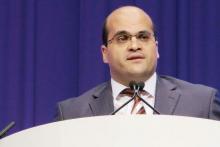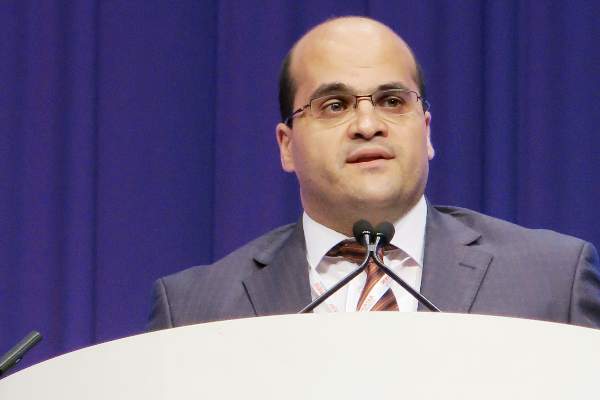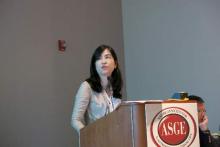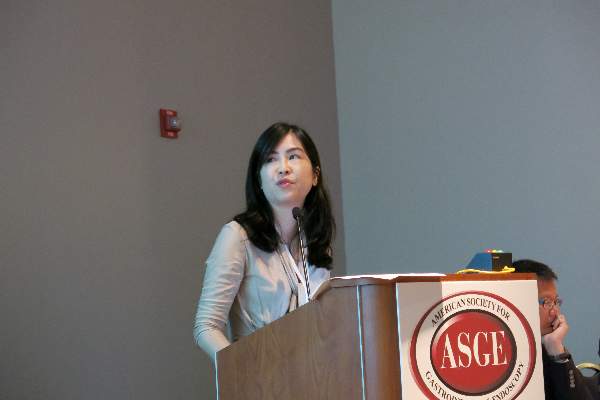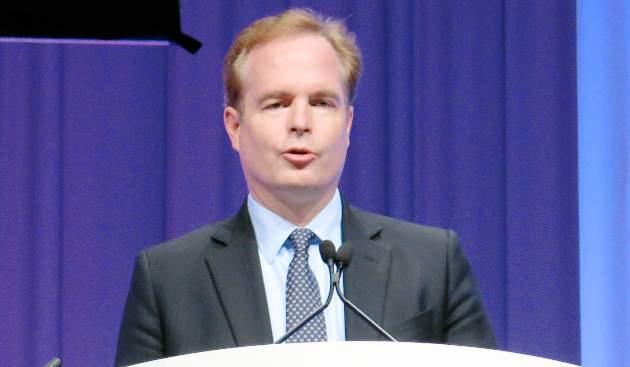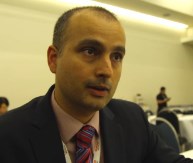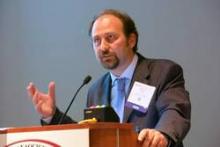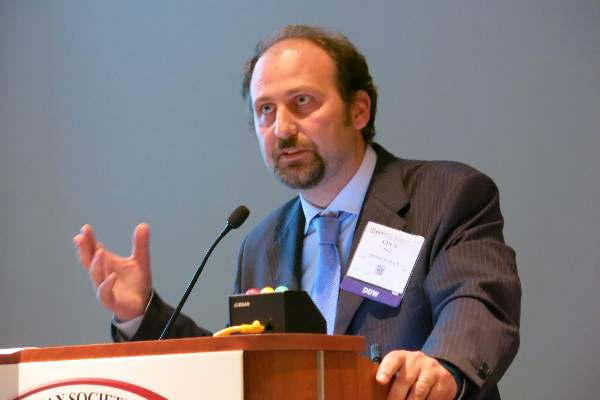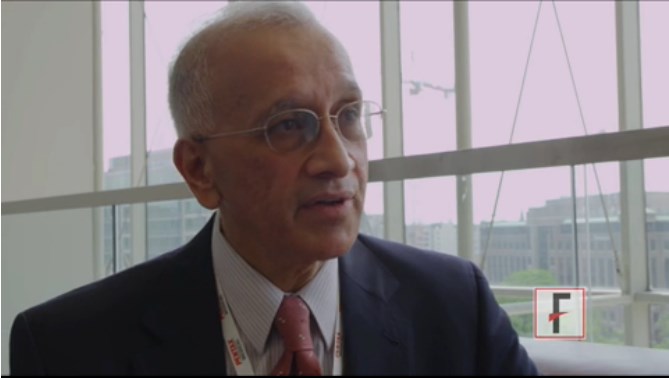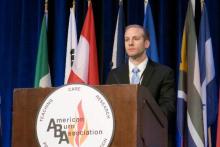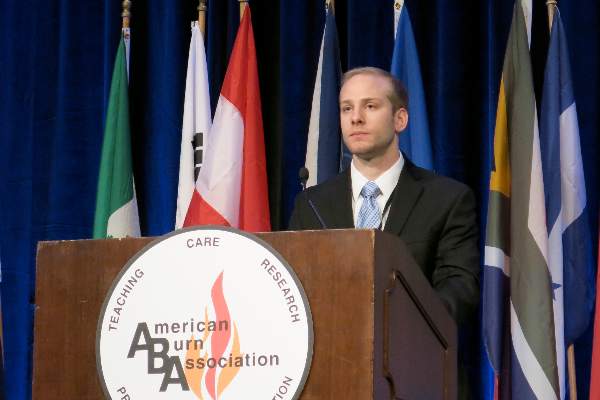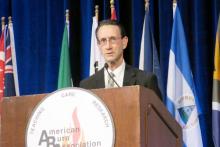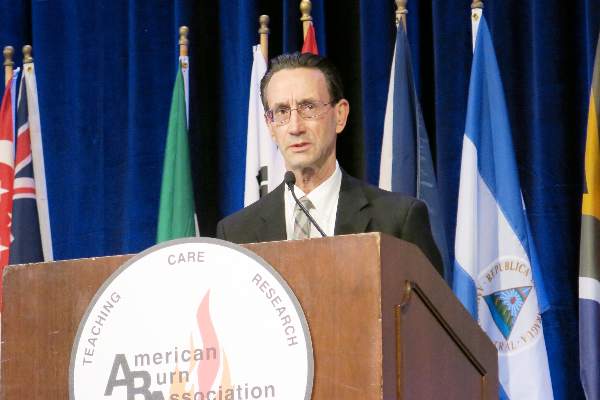User login
DDW: Intragastric balloon eyed for primary obesity intervention
WASHINGTON – Obese patients implanted with an intragastric balloon lost significantly more weight than those following a behavioral modification program in a randomized, nonblinded trial.
Moreover, weight loss was preserved even after device removal, study author Dr. Barham Abu Dayyeh said at the annual Digestive Disease Week.
The Orbera intragastric balloon (Apollo Endosurgery) could fill a gap in the United States between obesity lifestyle interventions that are minimally effective and a range of bariatric surgical interventions that are effective, but come at a cost of increased complications and health care costs, he said. Moreover, only 1% of qualified patients actually end up having bariatric surgery.
The silicone, saline-filled intragastric balloon (IGB) has been widely used outside the U.S. for more than 17 years in more than 200,000 patients, added Dr. Abu Dayyeh* of Mayo Clinic in Rochester, Minn.
The multicenter trial was designed for premarketing approval in the U.S. of the Orbera IGB and randomly assigned 273 adults with a body mass index (BMI) of 30-40 kg/m2 for more than 2 years to a 12-month behavioral modification program with or without endoscopic placement of the IGB filled to 500-600 cc. The balloon was removed at month 6, with regular office visits through 1 year.
Eighteen patients withdrew before treatment; 215 patients were evaluable at 6 months, 206 at 9 months, and 191 at 12 months. The mean baseline BMI was 35 kg/m2 and 90% of patients were female.
At 6 months, the mean percent total body weight loss was greater in the IGB group than the control group (about 10% vs. 4%; P < .001), Dr. Abu Dayyeh said, noting that total body weight loss was significantly higher in the balloon group at each time point: 3, 6, 9, and 12 months.
Similarly, the mean percent of excess weight loss at 6 months was better in the balloon group than in the control group (about 40% vs. 13%; P < .001). The majority of excess weight loss achieved at 6 months was also maintained at 12 months, he said.
At 9 months (3 months after device removal), 45.6% of patients in the IGB group had an excess weight loss at least 15% higher than patients in the control group, which exceeded the 30% threshold set as a primary study outcome, he said.
The mean percent excess weight loss was 26.5% at 9 months in the balloon group, which also exceeded the 25% threshold set as a second primary outcome.
This IGB system “appears to meet the thresholds set forth by the ASGE/ASMBS PIVI for endoscopic bariatric therapies intended as a primary obesity intervention,” Dr. Abu Dayyeh said.
The American Society for Gastrointestinal Endoscopy/American Society for Metabolic and Bariatric Surgery PIVI (Preservation and Incorporation of Valuable endoscopic Innovations) recommends that endoscopic bariatric therapies intended as a primary obesity intervention achieve a mean minimum threshold of 25% excess weight loss at 12 months.
At 52 weeks, both groups had an improvement from baseline in diabetes, hypertension, and lipids, but the improvement was greater with the IGB, he said.
Beck Depression Scores and quality of life also improved in both groups, with the improvement again greater with the IGB.
Serious adverse events were reported by 7% of controls and 9.6% of the balloon group including 8 early removals for intolerance, 1 gastric outlet obstruction, 1 laryngospasm during placement, 1 case of severe abdominal cramping, and 1 case of severe dehydration.
Early device removals occurred in 22% of patients, 15 for symptoms and 13 at subject request, Dr. Abu Dayyeh said. No deaths occurred in the trial.
*Changed on July 8, 2015.
On Twitter @pwendl
WASHINGTON – Obese patients implanted with an intragastric balloon lost significantly more weight than those following a behavioral modification program in a randomized, nonblinded trial.
Moreover, weight loss was preserved even after device removal, study author Dr. Barham Abu Dayyeh said at the annual Digestive Disease Week.
The Orbera intragastric balloon (Apollo Endosurgery) could fill a gap in the United States between obesity lifestyle interventions that are minimally effective and a range of bariatric surgical interventions that are effective, but come at a cost of increased complications and health care costs, he said. Moreover, only 1% of qualified patients actually end up having bariatric surgery.
The silicone, saline-filled intragastric balloon (IGB) has been widely used outside the U.S. for more than 17 years in more than 200,000 patients, added Dr. Abu Dayyeh* of Mayo Clinic in Rochester, Minn.
The multicenter trial was designed for premarketing approval in the U.S. of the Orbera IGB and randomly assigned 273 adults with a body mass index (BMI) of 30-40 kg/m2 for more than 2 years to a 12-month behavioral modification program with or without endoscopic placement of the IGB filled to 500-600 cc. The balloon was removed at month 6, with regular office visits through 1 year.
Eighteen patients withdrew before treatment; 215 patients were evaluable at 6 months, 206 at 9 months, and 191 at 12 months. The mean baseline BMI was 35 kg/m2 and 90% of patients were female.
At 6 months, the mean percent total body weight loss was greater in the IGB group than the control group (about 10% vs. 4%; P < .001), Dr. Abu Dayyeh said, noting that total body weight loss was significantly higher in the balloon group at each time point: 3, 6, 9, and 12 months.
Similarly, the mean percent of excess weight loss at 6 months was better in the balloon group than in the control group (about 40% vs. 13%; P < .001). The majority of excess weight loss achieved at 6 months was also maintained at 12 months, he said.
At 9 months (3 months after device removal), 45.6% of patients in the IGB group had an excess weight loss at least 15% higher than patients in the control group, which exceeded the 30% threshold set as a primary study outcome, he said.
The mean percent excess weight loss was 26.5% at 9 months in the balloon group, which also exceeded the 25% threshold set as a second primary outcome.
This IGB system “appears to meet the thresholds set forth by the ASGE/ASMBS PIVI for endoscopic bariatric therapies intended as a primary obesity intervention,” Dr. Abu Dayyeh said.
The American Society for Gastrointestinal Endoscopy/American Society for Metabolic and Bariatric Surgery PIVI (Preservation and Incorporation of Valuable endoscopic Innovations) recommends that endoscopic bariatric therapies intended as a primary obesity intervention achieve a mean minimum threshold of 25% excess weight loss at 12 months.
At 52 weeks, both groups had an improvement from baseline in diabetes, hypertension, and lipids, but the improvement was greater with the IGB, he said.
Beck Depression Scores and quality of life also improved in both groups, with the improvement again greater with the IGB.
Serious adverse events were reported by 7% of controls and 9.6% of the balloon group including 8 early removals for intolerance, 1 gastric outlet obstruction, 1 laryngospasm during placement, 1 case of severe abdominal cramping, and 1 case of severe dehydration.
Early device removals occurred in 22% of patients, 15 for symptoms and 13 at subject request, Dr. Abu Dayyeh said. No deaths occurred in the trial.
*Changed on July 8, 2015.
On Twitter @pwendl
WASHINGTON – Obese patients implanted with an intragastric balloon lost significantly more weight than those following a behavioral modification program in a randomized, nonblinded trial.
Moreover, weight loss was preserved even after device removal, study author Dr. Barham Abu Dayyeh said at the annual Digestive Disease Week.
The Orbera intragastric balloon (Apollo Endosurgery) could fill a gap in the United States between obesity lifestyle interventions that are minimally effective and a range of bariatric surgical interventions that are effective, but come at a cost of increased complications and health care costs, he said. Moreover, only 1% of qualified patients actually end up having bariatric surgery.
The silicone, saline-filled intragastric balloon (IGB) has been widely used outside the U.S. for more than 17 years in more than 200,000 patients, added Dr. Abu Dayyeh* of Mayo Clinic in Rochester, Minn.
The multicenter trial was designed for premarketing approval in the U.S. of the Orbera IGB and randomly assigned 273 adults with a body mass index (BMI) of 30-40 kg/m2 for more than 2 years to a 12-month behavioral modification program with or without endoscopic placement of the IGB filled to 500-600 cc. The balloon was removed at month 6, with regular office visits through 1 year.
Eighteen patients withdrew before treatment; 215 patients were evaluable at 6 months, 206 at 9 months, and 191 at 12 months. The mean baseline BMI was 35 kg/m2 and 90% of patients were female.
At 6 months, the mean percent total body weight loss was greater in the IGB group than the control group (about 10% vs. 4%; P < .001), Dr. Abu Dayyeh said, noting that total body weight loss was significantly higher in the balloon group at each time point: 3, 6, 9, and 12 months.
Similarly, the mean percent of excess weight loss at 6 months was better in the balloon group than in the control group (about 40% vs. 13%; P < .001). The majority of excess weight loss achieved at 6 months was also maintained at 12 months, he said.
At 9 months (3 months after device removal), 45.6% of patients in the IGB group had an excess weight loss at least 15% higher than patients in the control group, which exceeded the 30% threshold set as a primary study outcome, he said.
The mean percent excess weight loss was 26.5% at 9 months in the balloon group, which also exceeded the 25% threshold set as a second primary outcome.
This IGB system “appears to meet the thresholds set forth by the ASGE/ASMBS PIVI for endoscopic bariatric therapies intended as a primary obesity intervention,” Dr. Abu Dayyeh said.
The American Society for Gastrointestinal Endoscopy/American Society for Metabolic and Bariatric Surgery PIVI (Preservation and Incorporation of Valuable endoscopic Innovations) recommends that endoscopic bariatric therapies intended as a primary obesity intervention achieve a mean minimum threshold of 25% excess weight loss at 12 months.
At 52 weeks, both groups had an improvement from baseline in diabetes, hypertension, and lipids, but the improvement was greater with the IGB, he said.
Beck Depression Scores and quality of life also improved in both groups, with the improvement again greater with the IGB.
Serious adverse events were reported by 7% of controls and 9.6% of the balloon group including 8 early removals for intolerance, 1 gastric outlet obstruction, 1 laryngospasm during placement, 1 case of severe abdominal cramping, and 1 case of severe dehydration.
Early device removals occurred in 22% of patients, 15 for symptoms and 13 at subject request, Dr. Abu Dayyeh said. No deaths occurred in the trial.
*Changed on July 8, 2015.
On Twitter @pwendl
AT DDW® 2015
Key clinical point: An intragastric balloon system is an effective adjunct to lifestyle intervention for weight loss in obese patients with a BMI of 30-40 kg/m2.
Major finding: Mean percent excess weight loss at 6 months was about 40% for the intragastric balloon group vs. 13% for controls (P < .001).
Data source: Prospective, randomized, nonblinded study in 273 obese patients with a BMI of 30-40 kg/m2.
Disclosures: Apollo Endosurgery sponsored the study. Dr. Dayyeh reported financial relationships with Apollo Endosurgery, Aspire Bariatrics, and GI Dynamics.
DDW: Antibiotic rifaximin eases functional dyspepsia symptoms
WASHINGTON – Two weeks of antibiotic therapy with rifaximin provided relief from functional dyspepsia symptoms in a phase III double-blind, randomized trial.
“This is the first study that demonstrates that rifaximin is efficacious in the treatment of functional dyspepsia, particularly for global dyspeptic symptoms, bloating, and possibly belching. Our finding may suggest a role for the gut microbiota in the pathogenesis of functional dyspepsia,” Dr. Victoria Tan said at the annual Digestive Disease Week.
Rifaximin (Xifaxan) works by reducing or altering bacteria in the gut and has been shown to be efficacious in the treatment of diarrhea-predominant irritable bowel syndrome. It is approved to treat traveler’s diarrhea caused by Escherichia coli and to prevent hepatic encephalopathy.
The study randomly assigned 95 consecutive adults with functional dyspepsia as per ROME III criteria who had a normal gastroscopy within the last 2 years, had active symptoms in the month prior to enrollment, and were Helicobacter pylori negative, to rifaximin 400 mg or placebo three times a day for 2 weeks. In all, 33 rifaximin and 39 placebo patients were evaluable for the primary efficacy outcome of adequate relief of global dyspeptic symptoms (either no or mild dyspeptic symptoms) at any of the follow-up time points.
At baseline, 77% of patients had moderate to severe global dyspepsia symptoms, 74% of the placebo group and 55%% of the rifaximin group had moderate to severe belching, and roughly half of all patients were not on any GI medications. Mean age of the patients was 52 years.
Global dyspepsia symptoms improved with rifaximin beginning at week 2 and significantly favored rifaximin by week 8, with 23.5% of rifaximin patients reporting moderate to severe symptoms compared with 47.4% given placebo (P value = .04), said Dr. Tan of the University of Hong Kong.
Rates of moderate to severe belching were significantly improved with rifaximin at week 4 compared with placebo (14.3% vs. 35.7%; P = .03), but this difference was no longer significant at week 8 (26.5% vs. 29%).
The story was similar for moderate to severe bloating: Rates declined significantly with rifaximin at week 4 (20% vs. 43%; P = .03), but were no longer significant at week 8 (26.5% vs. 34.2%), she said.
A subgroup analysis of female patients showed significant improvements in moderate to severe global dyspeptic symptoms with rifaximin compared with placebo at week 4 (20.8% vs. 59.4%; P = .006) and week 8 (20% vs. 48.4%; P = .048).
Treatment response was not reflected in change in hydrogen breath response, Dr. Tan said. Results of a 3-hour hydrogen breath test performed after a 12-hour overnight fast showed no differences between the rifaximin and placebo groups for H2 peak above baseline (2.94 ppm vs. 0.11 ppm; P = .29), H2 area under the curve (+43.64 ppm vs. –49.71 ppm; P = .76), and oro-cecal transit time (24.23 minutes vs. 16.5 minutes; P = .68).
Adverse events were very similar between the two groups at both 4 and 8 weeks, Dr. Tan said. Only one major event occurred, a severe case of acute hepatitis in a woman in the placebo arm who also took traditional Chinese herbs.
On Twitter @pwendl
WASHINGTON – Two weeks of antibiotic therapy with rifaximin provided relief from functional dyspepsia symptoms in a phase III double-blind, randomized trial.
“This is the first study that demonstrates that rifaximin is efficacious in the treatment of functional dyspepsia, particularly for global dyspeptic symptoms, bloating, and possibly belching. Our finding may suggest a role for the gut microbiota in the pathogenesis of functional dyspepsia,” Dr. Victoria Tan said at the annual Digestive Disease Week.
Rifaximin (Xifaxan) works by reducing or altering bacteria in the gut and has been shown to be efficacious in the treatment of diarrhea-predominant irritable bowel syndrome. It is approved to treat traveler’s diarrhea caused by Escherichia coli and to prevent hepatic encephalopathy.
The study randomly assigned 95 consecutive adults with functional dyspepsia as per ROME III criteria who had a normal gastroscopy within the last 2 years, had active symptoms in the month prior to enrollment, and were Helicobacter pylori negative, to rifaximin 400 mg or placebo three times a day for 2 weeks. In all, 33 rifaximin and 39 placebo patients were evaluable for the primary efficacy outcome of adequate relief of global dyspeptic symptoms (either no or mild dyspeptic symptoms) at any of the follow-up time points.
At baseline, 77% of patients had moderate to severe global dyspepsia symptoms, 74% of the placebo group and 55%% of the rifaximin group had moderate to severe belching, and roughly half of all patients were not on any GI medications. Mean age of the patients was 52 years.
Global dyspepsia symptoms improved with rifaximin beginning at week 2 and significantly favored rifaximin by week 8, with 23.5% of rifaximin patients reporting moderate to severe symptoms compared with 47.4% given placebo (P value = .04), said Dr. Tan of the University of Hong Kong.
Rates of moderate to severe belching were significantly improved with rifaximin at week 4 compared with placebo (14.3% vs. 35.7%; P = .03), but this difference was no longer significant at week 8 (26.5% vs. 29%).
The story was similar for moderate to severe bloating: Rates declined significantly with rifaximin at week 4 (20% vs. 43%; P = .03), but were no longer significant at week 8 (26.5% vs. 34.2%), she said.
A subgroup analysis of female patients showed significant improvements in moderate to severe global dyspeptic symptoms with rifaximin compared with placebo at week 4 (20.8% vs. 59.4%; P = .006) and week 8 (20% vs. 48.4%; P = .048).
Treatment response was not reflected in change in hydrogen breath response, Dr. Tan said. Results of a 3-hour hydrogen breath test performed after a 12-hour overnight fast showed no differences between the rifaximin and placebo groups for H2 peak above baseline (2.94 ppm vs. 0.11 ppm; P = .29), H2 area under the curve (+43.64 ppm vs. –49.71 ppm; P = .76), and oro-cecal transit time (24.23 minutes vs. 16.5 minutes; P = .68).
Adverse events were very similar between the two groups at both 4 and 8 weeks, Dr. Tan said. Only one major event occurred, a severe case of acute hepatitis in a woman in the placebo arm who also took traditional Chinese herbs.
On Twitter @pwendl
WASHINGTON – Two weeks of antibiotic therapy with rifaximin provided relief from functional dyspepsia symptoms in a phase III double-blind, randomized trial.
“This is the first study that demonstrates that rifaximin is efficacious in the treatment of functional dyspepsia, particularly for global dyspeptic symptoms, bloating, and possibly belching. Our finding may suggest a role for the gut microbiota in the pathogenesis of functional dyspepsia,” Dr. Victoria Tan said at the annual Digestive Disease Week.
Rifaximin (Xifaxan) works by reducing or altering bacteria in the gut and has been shown to be efficacious in the treatment of diarrhea-predominant irritable bowel syndrome. It is approved to treat traveler’s diarrhea caused by Escherichia coli and to prevent hepatic encephalopathy.
The study randomly assigned 95 consecutive adults with functional dyspepsia as per ROME III criteria who had a normal gastroscopy within the last 2 years, had active symptoms in the month prior to enrollment, and were Helicobacter pylori negative, to rifaximin 400 mg or placebo three times a day for 2 weeks. In all, 33 rifaximin and 39 placebo patients were evaluable for the primary efficacy outcome of adequate relief of global dyspeptic symptoms (either no or mild dyspeptic symptoms) at any of the follow-up time points.
At baseline, 77% of patients had moderate to severe global dyspepsia symptoms, 74% of the placebo group and 55%% of the rifaximin group had moderate to severe belching, and roughly half of all patients were not on any GI medications. Mean age of the patients was 52 years.
Global dyspepsia symptoms improved with rifaximin beginning at week 2 and significantly favored rifaximin by week 8, with 23.5% of rifaximin patients reporting moderate to severe symptoms compared with 47.4% given placebo (P value = .04), said Dr. Tan of the University of Hong Kong.
Rates of moderate to severe belching were significantly improved with rifaximin at week 4 compared with placebo (14.3% vs. 35.7%; P = .03), but this difference was no longer significant at week 8 (26.5% vs. 29%).
The story was similar for moderate to severe bloating: Rates declined significantly with rifaximin at week 4 (20% vs. 43%; P = .03), but were no longer significant at week 8 (26.5% vs. 34.2%), she said.
A subgroup analysis of female patients showed significant improvements in moderate to severe global dyspeptic symptoms with rifaximin compared with placebo at week 4 (20.8% vs. 59.4%; P = .006) and week 8 (20% vs. 48.4%; P = .048).
Treatment response was not reflected in change in hydrogen breath response, Dr. Tan said. Results of a 3-hour hydrogen breath test performed after a 12-hour overnight fast showed no differences between the rifaximin and placebo groups for H2 peak above baseline (2.94 ppm vs. 0.11 ppm; P = .29), H2 area under the curve (+43.64 ppm vs. –49.71 ppm; P = .76), and oro-cecal transit time (24.23 minutes vs. 16.5 minutes; P = .68).
Adverse events were very similar between the two groups at both 4 and 8 weeks, Dr. Tan said. Only one major event occurred, a severe case of acute hepatitis in a woman in the placebo arm who also took traditional Chinese herbs.
On Twitter @pwendl
AT DDW 2015
Key clinical point: A 2-week course of rifaximin is efficacious in the treatment of functional dyspepsia.
Major finding: At week 8, 23.5% of patients treated with rifaximin vs. 47.4% given placebo reported moderate to severe global dyspepsia symptoms (P = .04).
Data source: Phase III placebo-controlled trial of 95 consecutive patients with functional dyspepsia as per ROME III criteria who had a normal gastroscopy within the last 2 years, had active symptoms in the month prior to enrollment, and were H. pylori negative.
Disclosures: Chong Lap Pharmaceuticals supplied the study drugs, but had no input into the study. Dr. Tan reported having no financial disclosures.
DDW: Ozanimod active in moderate-severe UC, without cardiac signal in TOUCHSTONE trial
WASHINGTON– The oral S1P receptor modulator ozanimod is clinically active and well tolerated in patients with moderate to severe ulcerative colitis (UC), phase II study results show.
Importantly, no notable cardiac, opthalmologic, or infectious treatment-related adverse events were observed, Dr. William Sandborn said at the annual Digestive Disease Week.
The first sphingosine-1-phosphate (S1P) receptor modulator, Fingolimod (Gilenya), carries a warning for first-dose cardiac effects, liver function test elevations, and macular edema and targets S1P receptors 1, 3, 4, and 5. Ozanimod is a next-generation S1P receptor modulator that has increased selectivity for the S1P receptors 1 and 5, compared with receptor 3, which may be related to safety concerns with fingolimod, said Dr. Sandborn, chief of gastroenterology at the University of California-San Diego.
He reported on the double-blind, phase II TOUCHSTONE trial involving 197 adults with moderate to severe UC who were receiving oral aminosalicylates and/or prednisone, and were randomly assigned to receive ozanimod 0.5 mg (n = 65) or 1 mg (n = 67) or placebo (n = 65). Doses were titrated through week 1, followed by 8 weeks of full-dose therapy.
The study’s primary efficacy endpoint was the proportion of patients in clinical remission at week 8, defined as a Mayo score of 2 or less, with no subscore of more than 1.
At week 8, 16.4% of patients on ozanimod 1 mg were in remission vs. 6.2% on placebo (P = .0482) and 13.8% on ozanimod 0.5 mg (P = .1422), Dr. Sandborn reported.
Rates of clinical response at 8 weeks were 56.7% with the high-dose ozanimod, 53.8% with the low dose, and 37% with placebo. Once again, the between-group difference was significant only for high-dose ozanimod (P = .0207).
Mucosal improvement was significantly more common with either high-dose ozanimod (34.3% vs. 12.3% placebo; P = .0023) or low-dose ozanimod (27.7% vs. 12.3% placebo; P = .0348), he said.
The most common adverse events were anemia/decreased hemoglobin, occurring in four patients in the placebo and low-dose ozanimod groups, and worsening of UC, occurring in three patients on placebo, two on low-dose ozanimod, and one on high-dose ozanimod.
Serious treatment-related adverse events were reported in four patients on placebo, one on ozanimod 0.5 mg (hyperpyrexia), and one on ozanimod 1 mg (UC).
The overall incidence of cardiac events was low, with two palpitations reported in the placebo group, one sinus bradycardia and one first-degree AV block in the ozanimod 0.5-mg group, and none in the 1-mg group.
“Ozanimod was well tolerated with a favorable benefit-risk profile supporting the planned phase III trial in ulcerative colitis and the phase II study in Crohn’s disease,” said Dr. Sandborn, who also reported the results earlier this year in Europe.
On Twitter@pwendl
WASHINGTON– The oral S1P receptor modulator ozanimod is clinically active and well tolerated in patients with moderate to severe ulcerative colitis (UC), phase II study results show.
Importantly, no notable cardiac, opthalmologic, or infectious treatment-related adverse events were observed, Dr. William Sandborn said at the annual Digestive Disease Week.
The first sphingosine-1-phosphate (S1P) receptor modulator, Fingolimod (Gilenya), carries a warning for first-dose cardiac effects, liver function test elevations, and macular edema and targets S1P receptors 1, 3, 4, and 5. Ozanimod is a next-generation S1P receptor modulator that has increased selectivity for the S1P receptors 1 and 5, compared with receptor 3, which may be related to safety concerns with fingolimod, said Dr. Sandborn, chief of gastroenterology at the University of California-San Diego.
He reported on the double-blind, phase II TOUCHSTONE trial involving 197 adults with moderate to severe UC who were receiving oral aminosalicylates and/or prednisone, and were randomly assigned to receive ozanimod 0.5 mg (n = 65) or 1 mg (n = 67) or placebo (n = 65). Doses were titrated through week 1, followed by 8 weeks of full-dose therapy.
The study’s primary efficacy endpoint was the proportion of patients in clinical remission at week 8, defined as a Mayo score of 2 or less, with no subscore of more than 1.
At week 8, 16.4% of patients on ozanimod 1 mg were in remission vs. 6.2% on placebo (P = .0482) and 13.8% on ozanimod 0.5 mg (P = .1422), Dr. Sandborn reported.
Rates of clinical response at 8 weeks were 56.7% with the high-dose ozanimod, 53.8% with the low dose, and 37% with placebo. Once again, the between-group difference was significant only for high-dose ozanimod (P = .0207).
Mucosal improvement was significantly more common with either high-dose ozanimod (34.3% vs. 12.3% placebo; P = .0023) or low-dose ozanimod (27.7% vs. 12.3% placebo; P = .0348), he said.
The most common adverse events were anemia/decreased hemoglobin, occurring in four patients in the placebo and low-dose ozanimod groups, and worsening of UC, occurring in three patients on placebo, two on low-dose ozanimod, and one on high-dose ozanimod.
Serious treatment-related adverse events were reported in four patients on placebo, one on ozanimod 0.5 mg (hyperpyrexia), and one on ozanimod 1 mg (UC).
The overall incidence of cardiac events was low, with two palpitations reported in the placebo group, one sinus bradycardia and one first-degree AV block in the ozanimod 0.5-mg group, and none in the 1-mg group.
“Ozanimod was well tolerated with a favorable benefit-risk profile supporting the planned phase III trial in ulcerative colitis and the phase II study in Crohn’s disease,” said Dr. Sandborn, who also reported the results earlier this year in Europe.
On Twitter@pwendl
WASHINGTON– The oral S1P receptor modulator ozanimod is clinically active and well tolerated in patients with moderate to severe ulcerative colitis (UC), phase II study results show.
Importantly, no notable cardiac, opthalmologic, or infectious treatment-related adverse events were observed, Dr. William Sandborn said at the annual Digestive Disease Week.
The first sphingosine-1-phosphate (S1P) receptor modulator, Fingolimod (Gilenya), carries a warning for first-dose cardiac effects, liver function test elevations, and macular edema and targets S1P receptors 1, 3, 4, and 5. Ozanimod is a next-generation S1P receptor modulator that has increased selectivity for the S1P receptors 1 and 5, compared with receptor 3, which may be related to safety concerns with fingolimod, said Dr. Sandborn, chief of gastroenterology at the University of California-San Diego.
He reported on the double-blind, phase II TOUCHSTONE trial involving 197 adults with moderate to severe UC who were receiving oral aminosalicylates and/or prednisone, and were randomly assigned to receive ozanimod 0.5 mg (n = 65) or 1 mg (n = 67) or placebo (n = 65). Doses were titrated through week 1, followed by 8 weeks of full-dose therapy.
The study’s primary efficacy endpoint was the proportion of patients in clinical remission at week 8, defined as a Mayo score of 2 or less, with no subscore of more than 1.
At week 8, 16.4% of patients on ozanimod 1 mg were in remission vs. 6.2% on placebo (P = .0482) and 13.8% on ozanimod 0.5 mg (P = .1422), Dr. Sandborn reported.
Rates of clinical response at 8 weeks were 56.7% with the high-dose ozanimod, 53.8% with the low dose, and 37% with placebo. Once again, the between-group difference was significant only for high-dose ozanimod (P = .0207).
Mucosal improvement was significantly more common with either high-dose ozanimod (34.3% vs. 12.3% placebo; P = .0023) or low-dose ozanimod (27.7% vs. 12.3% placebo; P = .0348), he said.
The most common adverse events were anemia/decreased hemoglobin, occurring in four patients in the placebo and low-dose ozanimod groups, and worsening of UC, occurring in three patients on placebo, two on low-dose ozanimod, and one on high-dose ozanimod.
Serious treatment-related adverse events were reported in four patients on placebo, one on ozanimod 0.5 mg (hyperpyrexia), and one on ozanimod 1 mg (UC).
The overall incidence of cardiac events was low, with two palpitations reported in the placebo group, one sinus bradycardia and one first-degree AV block in the ozanimod 0.5-mg group, and none in the 1-mg group.
“Ozanimod was well tolerated with a favorable benefit-risk profile supporting the planned phase III trial in ulcerative colitis and the phase II study in Crohn’s disease,” said Dr. Sandborn, who also reported the results earlier this year in Europe.
On Twitter@pwendl
AT DDW 2015
Key clinical point: Ozanimod 1 mg induced clinical remission at week 8 in patients with moderate to severe ulcerative colitis.
Major finding: At week 8, 16.4% of patients on ozanimod 1 mg were in remission vs. 6.2% on placebo (P = .0482) and 13.8% on ozanimod 0.5 mg (P = .1422).
Data source: Randomized, double-blind trial of 197 patients with moderate to severe ulcerative colitis.
Disclosures: Dr. Sandborn reported financial relationships with numerous firms including Receptos, which funded the study.
VIDEO: Stroop app predicts hepatic encephalopathy
WASHINGTON – One of the many comorbidities of cirrhosis is hepatic encephalopathy and its development is insidious. Often the patient is unaware and symptoms may not be so obvious to the physician that testing seems imperative, according to Dr. Jasmohan Bajaj of Virginia Commonwealth University in Richmond and McGuire VAMC.
He and his coworkers have developed an easy-to-use smartphone screening tool that tests the patient’s cognitive speed and flexibility, which physicians can administer themselves without having to refer the patient to psychiatric services. Currently, the need for a referral often means that these end-stage liver patients are not screened or treated for hepatic encephalopathy until their cognitive symptoms are overt.
Dr. Bajaj has received support or consulting fees from, or has been on advisory committees for, Merz, Otsuka, Salix, and Grifols.
The video associated with this article is no longer available on this site. Please view all of our videos on the MDedge YouTube channel
WASHINGTON – One of the many comorbidities of cirrhosis is hepatic encephalopathy and its development is insidious. Often the patient is unaware and symptoms may not be so obvious to the physician that testing seems imperative, according to Dr. Jasmohan Bajaj of Virginia Commonwealth University in Richmond and McGuire VAMC.
He and his coworkers have developed an easy-to-use smartphone screening tool that tests the patient’s cognitive speed and flexibility, which physicians can administer themselves without having to refer the patient to psychiatric services. Currently, the need for a referral often means that these end-stage liver patients are not screened or treated for hepatic encephalopathy until their cognitive symptoms are overt.
Dr. Bajaj has received support or consulting fees from, or has been on advisory committees for, Merz, Otsuka, Salix, and Grifols.
The video associated with this article is no longer available on this site. Please view all of our videos on the MDedge YouTube channel
WASHINGTON – One of the many comorbidities of cirrhosis is hepatic encephalopathy and its development is insidious. Often the patient is unaware and symptoms may not be so obvious to the physician that testing seems imperative, according to Dr. Jasmohan Bajaj of Virginia Commonwealth University in Richmond and McGuire VAMC.
He and his coworkers have developed an easy-to-use smartphone screening tool that tests the patient’s cognitive speed and flexibility, which physicians can administer themselves without having to refer the patient to psychiatric services. Currently, the need for a referral often means that these end-stage liver patients are not screened or treated for hepatic encephalopathy until their cognitive symptoms are overt.
Dr. Bajaj has received support or consulting fees from, or has been on advisory committees for, Merz, Otsuka, Salix, and Grifols.
The video associated with this article is no longer available on this site. Please view all of our videos on the MDedge YouTube channel
AT DDW 2015
DDW: Scheduled for a colonoscopy? Pass the pretzels!
WASHINGTON – A novel, edible colon preparation could make obsolete the fasting and large volume of salty liquid cleansing that keep many a patient from completing their colonoscopies.
A pilot study showed that all 10 patients who ate a series of nutritionally balanced meals, drinks, and snacks such as pretzels and pudding had a successful colon cleansing according to the endoscopist at the time of the procedure, Dr. L. Campbell Levy of Dartmouth-Hitchcock Medical Center in Lebanon, N.H., reported at the annual Digestive Disease Week.
The preparation, which is blended with polyethylene glycol 3350, sorbitol, and ascorbic acid, did not produce any significant changes in electrolytes or creatinine.
There were no adverse events and, equally important, all 10 patients said that they would follow the edible bowel regimen again for a subsequent procedure.
In a video interview, he discussed the small study’s results and the plans for larger, randomized studies.
Dr. Levy reported no relevant conflicts. The inventor of the diet and the founder of Colonary Concepts were involved in the study.
The video associated with this article is no longer available on this site. Please view all of our videos on the MDedge YouTube channel
On Twitter @pwendl
WASHINGTON – A novel, edible colon preparation could make obsolete the fasting and large volume of salty liquid cleansing that keep many a patient from completing their colonoscopies.
A pilot study showed that all 10 patients who ate a series of nutritionally balanced meals, drinks, and snacks such as pretzels and pudding had a successful colon cleansing according to the endoscopist at the time of the procedure, Dr. L. Campbell Levy of Dartmouth-Hitchcock Medical Center in Lebanon, N.H., reported at the annual Digestive Disease Week.
The preparation, which is blended with polyethylene glycol 3350, sorbitol, and ascorbic acid, did not produce any significant changes in electrolytes or creatinine.
There were no adverse events and, equally important, all 10 patients said that they would follow the edible bowel regimen again for a subsequent procedure.
In a video interview, he discussed the small study’s results and the plans for larger, randomized studies.
Dr. Levy reported no relevant conflicts. The inventor of the diet and the founder of Colonary Concepts were involved in the study.
The video associated with this article is no longer available on this site. Please view all of our videos on the MDedge YouTube channel
On Twitter @pwendl
WASHINGTON – A novel, edible colon preparation could make obsolete the fasting and large volume of salty liquid cleansing that keep many a patient from completing their colonoscopies.
A pilot study showed that all 10 patients who ate a series of nutritionally balanced meals, drinks, and snacks such as pretzels and pudding had a successful colon cleansing according to the endoscopist at the time of the procedure, Dr. L. Campbell Levy of Dartmouth-Hitchcock Medical Center in Lebanon, N.H., reported at the annual Digestive Disease Week.
The preparation, which is blended with polyethylene glycol 3350, sorbitol, and ascorbic acid, did not produce any significant changes in electrolytes or creatinine.
There were no adverse events and, equally important, all 10 patients said that they would follow the edible bowel regimen again for a subsequent procedure.
In a video interview, he discussed the small study’s results and the plans for larger, randomized studies.
Dr. Levy reported no relevant conflicts. The inventor of the diet and the founder of Colonary Concepts were involved in the study.
The video associated with this article is no longer available on this site. Please view all of our videos on the MDedge YouTube channel
On Twitter @pwendl
AT DDW® 2015
The GLUTOX Trial: Getting closer to identifying nonceliac gluten sensitivity
WASHINGTON – A simple dietary challenge may help identify nonceliac gluten sensitivity in patients with gastrointestinal functional disorders, results of the ongoing, randomized GLUTOX trial suggest.
Nonceliac gluten sensitivity (NCGS) is an emergent syndrome that causes mainly gastrointestinal symptoms and has been thought to be present in about 6% of the population. The problem is that there is no established or well-defined diagnostic flow chart to identify these patients, study author Dr. Luca Elli said at the annual Digestive Disease Week.
To determine whether gluten induces symptoms in patients responding positively to a gluten-free diet and identify those potentially affected by NCGS, GLUTOXenrolled 100 adults with functional GI symptoms and placed them on a gluten-free diet for 21 days. Severity of symptoms was measured before and after the diet using a 10-cm visual analogue scale (VAS) and the 36-item Short Form Health Survey (SF-36).
Patients with at least a 3-cm improvement in baseline VAS were then double-blind, randomly assigned to gluten (5.6 g per day) or placebo capsules for 7 days, followed by a 7-day washout period, and then crossed over to another 7-day cycle of gluten or placebo capsules.
At baseline, the mean age was 38 years, 90% of patients were female, 55 had irritable bowel syndrome (IBS), 36 functional dyspepsia, and 9 had other unspecified functional nonspecific gastrointestinal symptoms by ROME III criteria. Patients with celiac disease or a wheat allergy or who were on an ongoing GFD were excluded.
In all, 81 patients reported a symptomatic improvement from baseline after the 21-day gluten-free-diet (mean VAS 7.5 vs. 3.3; P value = .001),Dr. Elli, from Fondazione IRCCS Ca’ Granda, Ospedale Maggiore Policlinico, Milan, Italy, reported in a distinguished abstract plenary session.
“All of the symptoms we found were reduced by the gluten-free diet, but especially patient satisfaction about stool consistency, bloating, and the global satisfaction were improved in an important way,” he said.
Symptom improvements were also associated with significant improvements in the SF-36 physical component summary and mental component summary. Most responders were female (88%), 48 had IBS, 25 dyspepsia, and 8 other.
After the gluten capsule challenge, 25 of the 81 gluten-free diet responders had a severe symptomatic relapse especially in stool consistency satisfaction, bloating, and abdominal pain, Dr. Elli said.
The relapses were also associated with a significant decrease in SF-36 physical and mental component summaries.
No demographic or biochemical parameters were significantly associated with a response to the gluten challenge, Dr. Elli said. Most of those having a response were female (96%), 13 had IBS, 10 dyspepsia, and 2 other.
The sequence of the gluten and placebo capsules also had no effect on the results.
If the data are confirmed, it’s possible the double-blind challenge could be used to select gluten-free diet responders and inserted into the diagnostic flow chart for patients with gastrointestinal functional disorders, Dr. Elli said.
A very important open issue is also the 56% of enrolled subjects who responded to the gluten-free diet, but did not show symptoms with the gluten double-blind challenge, he added.
During a discussion of the results, attendees questioned whether the study design, particularly the failure to biopsy patients for celiac disease at enrollment and the short 7-day washout period, was sufficient to answer the question of identifying patients with NCGS.
Session co-moderatorDr. Bernd Schnabl, from University of California–San Diego, agreed that the study design was not ideal and that the study would have been strengthened by using biopsy to rule out patients with celiac disease. That said, the study represents a start.
“If we can stratify these patients and re-challenge them longer, it could be helpful in identifying a subpopulation of functional patients who might benefit from a gluten-free diet,” he said.
The study was funded by Fondazione IRCCS Ca’ Granda, Ospedale Maggiore Policlinico. Dr. Elli reported consulting fees from and serving on an advisory committee or review panel for the Dr. Schär Institute.
On Twitter @pwendl
WASHINGTON – A simple dietary challenge may help identify nonceliac gluten sensitivity in patients with gastrointestinal functional disorders, results of the ongoing, randomized GLUTOX trial suggest.
Nonceliac gluten sensitivity (NCGS) is an emergent syndrome that causes mainly gastrointestinal symptoms and has been thought to be present in about 6% of the population. The problem is that there is no established or well-defined diagnostic flow chart to identify these patients, study author Dr. Luca Elli said at the annual Digestive Disease Week.
To determine whether gluten induces symptoms in patients responding positively to a gluten-free diet and identify those potentially affected by NCGS, GLUTOXenrolled 100 adults with functional GI symptoms and placed them on a gluten-free diet for 21 days. Severity of symptoms was measured before and after the diet using a 10-cm visual analogue scale (VAS) and the 36-item Short Form Health Survey (SF-36).
Patients with at least a 3-cm improvement in baseline VAS were then double-blind, randomly assigned to gluten (5.6 g per day) or placebo capsules for 7 days, followed by a 7-day washout period, and then crossed over to another 7-day cycle of gluten or placebo capsules.
At baseline, the mean age was 38 years, 90% of patients were female, 55 had irritable bowel syndrome (IBS), 36 functional dyspepsia, and 9 had other unspecified functional nonspecific gastrointestinal symptoms by ROME III criteria. Patients with celiac disease or a wheat allergy or who were on an ongoing GFD were excluded.
In all, 81 patients reported a symptomatic improvement from baseline after the 21-day gluten-free-diet (mean VAS 7.5 vs. 3.3; P value = .001),Dr. Elli, from Fondazione IRCCS Ca’ Granda, Ospedale Maggiore Policlinico, Milan, Italy, reported in a distinguished abstract plenary session.
“All of the symptoms we found were reduced by the gluten-free diet, but especially patient satisfaction about stool consistency, bloating, and the global satisfaction were improved in an important way,” he said.
Symptom improvements were also associated with significant improvements in the SF-36 physical component summary and mental component summary. Most responders were female (88%), 48 had IBS, 25 dyspepsia, and 8 other.
After the gluten capsule challenge, 25 of the 81 gluten-free diet responders had a severe symptomatic relapse especially in stool consistency satisfaction, bloating, and abdominal pain, Dr. Elli said.
The relapses were also associated with a significant decrease in SF-36 physical and mental component summaries.
No demographic or biochemical parameters were significantly associated with a response to the gluten challenge, Dr. Elli said. Most of those having a response were female (96%), 13 had IBS, 10 dyspepsia, and 2 other.
The sequence of the gluten and placebo capsules also had no effect on the results.
If the data are confirmed, it’s possible the double-blind challenge could be used to select gluten-free diet responders and inserted into the diagnostic flow chart for patients with gastrointestinal functional disorders, Dr. Elli said.
A very important open issue is also the 56% of enrolled subjects who responded to the gluten-free diet, but did not show symptoms with the gluten double-blind challenge, he added.
During a discussion of the results, attendees questioned whether the study design, particularly the failure to biopsy patients for celiac disease at enrollment and the short 7-day washout period, was sufficient to answer the question of identifying patients with NCGS.
Session co-moderatorDr. Bernd Schnabl, from University of California–San Diego, agreed that the study design was not ideal and that the study would have been strengthened by using biopsy to rule out patients with celiac disease. That said, the study represents a start.
“If we can stratify these patients and re-challenge them longer, it could be helpful in identifying a subpopulation of functional patients who might benefit from a gluten-free diet,” he said.
The study was funded by Fondazione IRCCS Ca’ Granda, Ospedale Maggiore Policlinico. Dr. Elli reported consulting fees from and serving on an advisory committee or review panel for the Dr. Schär Institute.
On Twitter @pwendl
WASHINGTON – A simple dietary challenge may help identify nonceliac gluten sensitivity in patients with gastrointestinal functional disorders, results of the ongoing, randomized GLUTOX trial suggest.
Nonceliac gluten sensitivity (NCGS) is an emergent syndrome that causes mainly gastrointestinal symptoms and has been thought to be present in about 6% of the population. The problem is that there is no established or well-defined diagnostic flow chart to identify these patients, study author Dr. Luca Elli said at the annual Digestive Disease Week.
To determine whether gluten induces symptoms in patients responding positively to a gluten-free diet and identify those potentially affected by NCGS, GLUTOXenrolled 100 adults with functional GI symptoms and placed them on a gluten-free diet for 21 days. Severity of symptoms was measured before and after the diet using a 10-cm visual analogue scale (VAS) and the 36-item Short Form Health Survey (SF-36).
Patients with at least a 3-cm improvement in baseline VAS were then double-blind, randomly assigned to gluten (5.6 g per day) or placebo capsules for 7 days, followed by a 7-day washout period, and then crossed over to another 7-day cycle of gluten or placebo capsules.
At baseline, the mean age was 38 years, 90% of patients were female, 55 had irritable bowel syndrome (IBS), 36 functional dyspepsia, and 9 had other unspecified functional nonspecific gastrointestinal symptoms by ROME III criteria. Patients with celiac disease or a wheat allergy or who were on an ongoing GFD were excluded.
In all, 81 patients reported a symptomatic improvement from baseline after the 21-day gluten-free-diet (mean VAS 7.5 vs. 3.3; P value = .001),Dr. Elli, from Fondazione IRCCS Ca’ Granda, Ospedale Maggiore Policlinico, Milan, Italy, reported in a distinguished abstract plenary session.
“All of the symptoms we found were reduced by the gluten-free diet, but especially patient satisfaction about stool consistency, bloating, and the global satisfaction were improved in an important way,” he said.
Symptom improvements were also associated with significant improvements in the SF-36 physical component summary and mental component summary. Most responders were female (88%), 48 had IBS, 25 dyspepsia, and 8 other.
After the gluten capsule challenge, 25 of the 81 gluten-free diet responders had a severe symptomatic relapse especially in stool consistency satisfaction, bloating, and abdominal pain, Dr. Elli said.
The relapses were also associated with a significant decrease in SF-36 physical and mental component summaries.
No demographic or biochemical parameters were significantly associated with a response to the gluten challenge, Dr. Elli said. Most of those having a response were female (96%), 13 had IBS, 10 dyspepsia, and 2 other.
The sequence of the gluten and placebo capsules also had no effect on the results.
If the data are confirmed, it’s possible the double-blind challenge could be used to select gluten-free diet responders and inserted into the diagnostic flow chart for patients with gastrointestinal functional disorders, Dr. Elli said.
A very important open issue is also the 56% of enrolled subjects who responded to the gluten-free diet, but did not show symptoms with the gluten double-blind challenge, he added.
During a discussion of the results, attendees questioned whether the study design, particularly the failure to biopsy patients for celiac disease at enrollment and the short 7-day washout period, was sufficient to answer the question of identifying patients with NCGS.
Session co-moderatorDr. Bernd Schnabl, from University of California–San Diego, agreed that the study design was not ideal and that the study would have been strengthened by using biopsy to rule out patients with celiac disease. That said, the study represents a start.
“If we can stratify these patients and re-challenge them longer, it could be helpful in identifying a subpopulation of functional patients who might benefit from a gluten-free diet,” he said.
The study was funded by Fondazione IRCCS Ca’ Granda, Ospedale Maggiore Policlinico. Dr. Elli reported consulting fees from and serving on an advisory committee or review panel for the Dr. Schär Institute.
On Twitter @pwendl
AT DDW 2015
Key clinical point: A randomized, double-blind dietary challenge may be useful in identifying nonceliac gluten sensitivity.
Major finding: More than 30% of patients with functional gastrointestinal disorders were classified as possibly having nonceliac gluten sensitivity.
Data source: Randomized, double-blind study in 100 patients with suspected nonceliac gluten sensitivity.
Disclosures: The study was funded by Fondazione IRCCS Ca’ Granda, Ospedale Maggiore Policlinico. Dr. Elli reported consulting fees from and serving on an advisory committee or review panel for the Dr. Schär Institute.
DDW: VIDEO: What we don’t know in the management of liver disease and coagulopathy
WASHINGTON – Your patient has cirrhosis, platelets 60,000 mm3, an INR of 2.0, serum creatinine of 1.2 mg/dL, and requires an endoscopic retrograde cholangiopancreatography with sphincterotomy.
What do you do next?
Management of a patient such as this is challenging, but not just because of the long-perceived risk for bleeding, Dr. Patrick S. Kamath of the Mayo Clinic in Rochester, Minn., said during a clinical symposium at the annual Digestive Disease Week.
Several other factors must be considered, including the clotting risk in patients with liver disease and the fact that procedure-related bleeding risk cannot be adequately determined preprocedure. Transfusions also carry their own dangers in this patient population and should be approached with caution, he said.
To hear more from this world-renowned liver expert, check out our interview as we sat down with Dr. Kamath at this year’s DDW.
Dr. Kamath reported no relevant financial conflicts.
The video associated with this article is no longer available on this site. Please view all of our videos on the MDedge YouTube channel
On Twitter @pwendl
WASHINGTON – Your patient has cirrhosis, platelets 60,000 mm3, an INR of 2.0, serum creatinine of 1.2 mg/dL, and requires an endoscopic retrograde cholangiopancreatography with sphincterotomy.
What do you do next?
Management of a patient such as this is challenging, but not just because of the long-perceived risk for bleeding, Dr. Patrick S. Kamath of the Mayo Clinic in Rochester, Minn., said during a clinical symposium at the annual Digestive Disease Week.
Several other factors must be considered, including the clotting risk in patients with liver disease and the fact that procedure-related bleeding risk cannot be adequately determined preprocedure. Transfusions also carry their own dangers in this patient population and should be approached with caution, he said.
To hear more from this world-renowned liver expert, check out our interview as we sat down with Dr. Kamath at this year’s DDW.
Dr. Kamath reported no relevant financial conflicts.
The video associated with this article is no longer available on this site. Please view all of our videos on the MDedge YouTube channel
On Twitter @pwendl
WASHINGTON – Your patient has cirrhosis, platelets 60,000 mm3, an INR of 2.0, serum creatinine of 1.2 mg/dL, and requires an endoscopic retrograde cholangiopancreatography with sphincterotomy.
What do you do next?
Management of a patient such as this is challenging, but not just because of the long-perceived risk for bleeding, Dr. Patrick S. Kamath of the Mayo Clinic in Rochester, Minn., said during a clinical symposium at the annual Digestive Disease Week.
Several other factors must be considered, including the clotting risk in patients with liver disease and the fact that procedure-related bleeding risk cannot be adequately determined preprocedure. Transfusions also carry their own dangers in this patient population and should be approached with caution, he said.
To hear more from this world-renowned liver expert, check out our interview as we sat down with Dr. Kamath at this year’s DDW.
Dr. Kamath reported no relevant financial conflicts.
The video associated with this article is no longer available on this site. Please view all of our videos on the MDedge YouTube channel
On Twitter @pwendl
AT DDW 2015
AACR: HPV vaccine may protect some women with prior exposure
The human papillomavirus vaccine may afford protection to some women with prior HPV exposure, based on the results of a post-hoc analysis of the HPV Vaccine Trial in Costa Rica.
At the 4-year follow-up visit, multi-site efficacy against HPV16/18 DNA at the cervical, anal, or oral region was, as expected, the strongest at 84% among HPV-naive women who received the vaccine, but significant multi-site efficacy of 58% also was seen among women with evidence of HPV exposure prior to vaccination. Vaccine efficacy was nonsignificant at 25% in women with active cervical infection at vaccination, indicating that the vaccine is not therapeutic, study author Daniel C. Beachler, Ph.D., reported at the annual meeting of the American Association for Cancer Research.
The findings support current U.S. guidelines from the Centers for Disease Control and Prevention recommending routine vaccination for those aged 11-12 years, and vaccination through age 26 for those not previously vaccinated. HPV vaccination is known to be highly effective at cervical, anal, and oral regions in HPV-naive individuals and to have reduced impact in women aged 18-25.
What’s unknown is the combined multi-site vaccine efficacy on an individual basis, and whether HPV vaccine protects noninfected sites against HPV infection, Dr. Beachler, a postdoctoral fellow in the Infections and Immunoepidemiology Branch of the National Cancer Institute, said.
The phase III, National Cancer Institute HPV Vaccine Trial in Costa Rica enrolled 7,466 women, aged 18-25 years, over 6 months and randomly assigned them to one of three doses of the HPV16/18 vaccine (Cervarix) or to a hepatitis A vaccine (Havrix). Cervical samples were collected at every annual visit. Oral and anal samples were collected at only the 4-year follow-up visit. A total of 4,186 women contributed samples for all three sites and were included in the analysis.
Samples were tested for alpha mucosal HPV DNA types utilizing the SPF10 PCR-DEIA-LiPA25 system, version 1. An HPV event was defined as a woman with prevalent HPV16/18 DNA at the cervical, anal, or oral regions.
HPV naive was defined as HPV 16/18 seronegative and cervical HPV 16/18 DNA negative, prior infection was defined as HPV 16/18 antibody positive and cervical HPV 16/18 DNA negative, and active infection was defined as cervical HPV16/18 DNA positive.
Among all 4,186 women, multi-site vaccine efficacy at the 4-year visit was 65%, Dr. Beachler said.
HPV vaccinated women had fewer concordant infections, with vaccine efficacy reaching 91% for protection of at least two or three sites.
Indeed, only 7% of HPV 16/18-infected women in the vaccine arm had that same HPV type at two or more anatomic sites, compared with 30% of HPV 16/18-infected women in the control arm (P value < .01), again “giving support that the vaccine may provide some protection against uninfected sites in previously exposed women,” Dr. Beachler said.
He pointed out that the one-time sampling of oral and anal HPV and misclassification in assays could have affected the results. If complete information were available, vaccine efficacy would likely have been closer to 100% in the HPV-naive subgroup, he said.
Follow-up is continuing in the trial to determine the duration of protection, but there is still strong evidence of protection at 9 years, suggesting a booster dose is not necessary, Dr. Beachler said.
Further research of HPV infection outside the cervix, however, is very much needed.
“We know that only a certain percentage, 60%-70% of people who are infected, actually develop a serological response. We don’t even really know if an oral HPV infection or an anal HPV infection produces a serological response. We really need to understand HPV outside the cervix,” he said.
The National Cancer Institute funded the study. GlaxoSmithKline provided vaccines and support for regulatory aspects of the trial. Dr. Beachler declared no financial disclosures.
The human papillomavirus vaccine may afford protection to some women with prior HPV exposure, based on the results of a post-hoc analysis of the HPV Vaccine Trial in Costa Rica.
At the 4-year follow-up visit, multi-site efficacy against HPV16/18 DNA at the cervical, anal, or oral region was, as expected, the strongest at 84% among HPV-naive women who received the vaccine, but significant multi-site efficacy of 58% also was seen among women with evidence of HPV exposure prior to vaccination. Vaccine efficacy was nonsignificant at 25% in women with active cervical infection at vaccination, indicating that the vaccine is not therapeutic, study author Daniel C. Beachler, Ph.D., reported at the annual meeting of the American Association for Cancer Research.
The findings support current U.S. guidelines from the Centers for Disease Control and Prevention recommending routine vaccination for those aged 11-12 years, and vaccination through age 26 for those not previously vaccinated. HPV vaccination is known to be highly effective at cervical, anal, and oral regions in HPV-naive individuals and to have reduced impact in women aged 18-25.
What’s unknown is the combined multi-site vaccine efficacy on an individual basis, and whether HPV vaccine protects noninfected sites against HPV infection, Dr. Beachler, a postdoctoral fellow in the Infections and Immunoepidemiology Branch of the National Cancer Institute, said.
The phase III, National Cancer Institute HPV Vaccine Trial in Costa Rica enrolled 7,466 women, aged 18-25 years, over 6 months and randomly assigned them to one of three doses of the HPV16/18 vaccine (Cervarix) or to a hepatitis A vaccine (Havrix). Cervical samples were collected at every annual visit. Oral and anal samples were collected at only the 4-year follow-up visit. A total of 4,186 women contributed samples for all three sites and were included in the analysis.
Samples were tested for alpha mucosal HPV DNA types utilizing the SPF10 PCR-DEIA-LiPA25 system, version 1. An HPV event was defined as a woman with prevalent HPV16/18 DNA at the cervical, anal, or oral regions.
HPV naive was defined as HPV 16/18 seronegative and cervical HPV 16/18 DNA negative, prior infection was defined as HPV 16/18 antibody positive and cervical HPV 16/18 DNA negative, and active infection was defined as cervical HPV16/18 DNA positive.
Among all 4,186 women, multi-site vaccine efficacy at the 4-year visit was 65%, Dr. Beachler said.
HPV vaccinated women had fewer concordant infections, with vaccine efficacy reaching 91% for protection of at least two or three sites.
Indeed, only 7% of HPV 16/18-infected women in the vaccine arm had that same HPV type at two or more anatomic sites, compared with 30% of HPV 16/18-infected women in the control arm (P value < .01), again “giving support that the vaccine may provide some protection against uninfected sites in previously exposed women,” Dr. Beachler said.
He pointed out that the one-time sampling of oral and anal HPV and misclassification in assays could have affected the results. If complete information were available, vaccine efficacy would likely have been closer to 100% in the HPV-naive subgroup, he said.
Follow-up is continuing in the trial to determine the duration of protection, but there is still strong evidence of protection at 9 years, suggesting a booster dose is not necessary, Dr. Beachler said.
Further research of HPV infection outside the cervix, however, is very much needed.
“We know that only a certain percentage, 60%-70% of people who are infected, actually develop a serological response. We don’t even really know if an oral HPV infection or an anal HPV infection produces a serological response. We really need to understand HPV outside the cervix,” he said.
The National Cancer Institute funded the study. GlaxoSmithKline provided vaccines and support for regulatory aspects of the trial. Dr. Beachler declared no financial disclosures.
The human papillomavirus vaccine may afford protection to some women with prior HPV exposure, based on the results of a post-hoc analysis of the HPV Vaccine Trial in Costa Rica.
At the 4-year follow-up visit, multi-site efficacy against HPV16/18 DNA at the cervical, anal, or oral region was, as expected, the strongest at 84% among HPV-naive women who received the vaccine, but significant multi-site efficacy of 58% also was seen among women with evidence of HPV exposure prior to vaccination. Vaccine efficacy was nonsignificant at 25% in women with active cervical infection at vaccination, indicating that the vaccine is not therapeutic, study author Daniel C. Beachler, Ph.D., reported at the annual meeting of the American Association for Cancer Research.
The findings support current U.S. guidelines from the Centers for Disease Control and Prevention recommending routine vaccination for those aged 11-12 years, and vaccination through age 26 for those not previously vaccinated. HPV vaccination is known to be highly effective at cervical, anal, and oral regions in HPV-naive individuals and to have reduced impact in women aged 18-25.
What’s unknown is the combined multi-site vaccine efficacy on an individual basis, and whether HPV vaccine protects noninfected sites against HPV infection, Dr. Beachler, a postdoctoral fellow in the Infections and Immunoepidemiology Branch of the National Cancer Institute, said.
The phase III, National Cancer Institute HPV Vaccine Trial in Costa Rica enrolled 7,466 women, aged 18-25 years, over 6 months and randomly assigned them to one of three doses of the HPV16/18 vaccine (Cervarix) or to a hepatitis A vaccine (Havrix). Cervical samples were collected at every annual visit. Oral and anal samples were collected at only the 4-year follow-up visit. A total of 4,186 women contributed samples for all three sites and were included in the analysis.
Samples were tested for alpha mucosal HPV DNA types utilizing the SPF10 PCR-DEIA-LiPA25 system, version 1. An HPV event was defined as a woman with prevalent HPV16/18 DNA at the cervical, anal, or oral regions.
HPV naive was defined as HPV 16/18 seronegative and cervical HPV 16/18 DNA negative, prior infection was defined as HPV 16/18 antibody positive and cervical HPV 16/18 DNA negative, and active infection was defined as cervical HPV16/18 DNA positive.
Among all 4,186 women, multi-site vaccine efficacy at the 4-year visit was 65%, Dr. Beachler said.
HPV vaccinated women had fewer concordant infections, with vaccine efficacy reaching 91% for protection of at least two or three sites.
Indeed, only 7% of HPV 16/18-infected women in the vaccine arm had that same HPV type at two or more anatomic sites, compared with 30% of HPV 16/18-infected women in the control arm (P value < .01), again “giving support that the vaccine may provide some protection against uninfected sites in previously exposed women,” Dr. Beachler said.
He pointed out that the one-time sampling of oral and anal HPV and misclassification in assays could have affected the results. If complete information were available, vaccine efficacy would likely have been closer to 100% in the HPV-naive subgroup, he said.
Follow-up is continuing in the trial to determine the duration of protection, but there is still strong evidence of protection at 9 years, suggesting a booster dose is not necessary, Dr. Beachler said.
Further research of HPV infection outside the cervix, however, is very much needed.
“We know that only a certain percentage, 60%-70% of people who are infected, actually develop a serological response. We don’t even really know if an oral HPV infection or an anal HPV infection produces a serological response. We really need to understand HPV outside the cervix,” he said.
The National Cancer Institute funded the study. GlaxoSmithKline provided vaccines and support for regulatory aspects of the trial. Dr. Beachler declared no financial disclosures.
FROM THE AACR ANNUAL MEETING
Key clinical point: HPV vaccination provided strong protection at multiple anatomic sites in women without prior HPV exposure, and may still offer protection in those with prior exposure.
Major finding: Multi-site efficacy against HPV16/18 was 84% in HPV-naive women, and 58% in women with prior exposure.
Data source: Post-hoc analysis of 4,186 women in the HPV Vaccine Trial in Costa Rica.
Disclosures: The National Cancer Institute funded the study. GlaxoSmithKline provided vaccines and support for regulatory aspects of the trial. Dr. Beachler declared no financial disclosures.
ABA: Childhood burn survivors risk more physical, mental disorders
CHICAGO – Adult survivors of childhood burns have significantly higher rates of Axis I mental and physical disorders years after their injury, a population-based study shows.
“We think it is really important to screen for, identify, and treat these illnesses not only in that acute period and shortly after the burn injury, but well into adulthood,” study author James Stone said at the annual meeting of the American Burn Association.
He reported on 745 adult burn survivors identified using administrative data from a regional pediatric burn center registry in Manitoba, Canada, who were matched 1:5 with 3,725 controls from the general Manitoba population based on age, sex, and geographic location. The burn survivors had an average age of 5.9 years at the time of burn injury, burns involved an average 12% of total body surface area, and 65% of burn survivors were male. The average follow-up was nearly 15 years (range 2.8-24.7 years).
In unadjusted univariate analysis, adult survivors had significantly higher rates than matched controls for any lifetime physical disorder (rate ratio, 1.17), arthritis (RR, 1.23), cancer (RR, 1.94), diabetes (RR, 1.69), fractures (RR, 1.45), and total respiratory morbidity (RR, 1.15).
After adjustment for gender, geography, and income, any physical disorder (RR, 1.15; P value < .01), arthritis (RR, 1.24; P < .01), fractures (RR, 1.37; P .001), and total respiratory morbidity (RR, 1.13; P < .05) remained significant, Mr. Stone, from the University of Manitoba, Winnipeg, Canada, reported.
Further, 81% of burn survivors had a lifetime physical illness compared with 69% of controls.
“The fact that 81% of our burn cohort was diagnosed with a physical illness is definitely concerning,” he said. “We hypothesize that the prolonged hyperinflammatory and hypermetabolic state that has been previously reported makes these individuals more susceptible to these illnesses down the road.”
The burn cohort also had significantly higher unadjusted rate ratios for any Axis 1 mental disorder (RR, 1.62), major depressive disorder (RR, 1.64), anxiety (RR, 1.57), substance abuse (RR, 2.86), and suicide attempts (RR, 5.00).
All disorders remained statistically significant after adjustment with rate ratios of 1.54 (P < .001), 1.54 (P < .001), 1.50 (P < .001), 2.35 (P < .001), and 4.33 (P < .01), respectively.
The high rates of substance abuse and suicide attempts are consistent with previous clinical interview studies, but are still cause for great concern, Mr. Stone said.
The risk for any mental or physical disorder was not significantly impacted by burn location or by burns that affected more than 30% of total body surface area. Age older than 5 years at the time of the burn significantly increased the risk of any mental disorder (relative risk, 1.92; P < .001).
Limitations of the study include the potential for bias because the data relied on individuals presenting to physicians, discrepancies between ICD codes for physician billings and hospital claims, and some survivors may have moved out of the province, Mr. Stone said. The study, however, had a sample size three times greater than the next largest study of its kind, and importantly, matched burn patients to the general population.
CHICAGO – Adult survivors of childhood burns have significantly higher rates of Axis I mental and physical disorders years after their injury, a population-based study shows.
“We think it is really important to screen for, identify, and treat these illnesses not only in that acute period and shortly after the burn injury, but well into adulthood,” study author James Stone said at the annual meeting of the American Burn Association.
He reported on 745 adult burn survivors identified using administrative data from a regional pediatric burn center registry in Manitoba, Canada, who were matched 1:5 with 3,725 controls from the general Manitoba population based on age, sex, and geographic location. The burn survivors had an average age of 5.9 years at the time of burn injury, burns involved an average 12% of total body surface area, and 65% of burn survivors were male. The average follow-up was nearly 15 years (range 2.8-24.7 years).
In unadjusted univariate analysis, adult survivors had significantly higher rates than matched controls for any lifetime physical disorder (rate ratio, 1.17), arthritis (RR, 1.23), cancer (RR, 1.94), diabetes (RR, 1.69), fractures (RR, 1.45), and total respiratory morbidity (RR, 1.15).
After adjustment for gender, geography, and income, any physical disorder (RR, 1.15; P value < .01), arthritis (RR, 1.24; P < .01), fractures (RR, 1.37; P .001), and total respiratory morbidity (RR, 1.13; P < .05) remained significant, Mr. Stone, from the University of Manitoba, Winnipeg, Canada, reported.
Further, 81% of burn survivors had a lifetime physical illness compared with 69% of controls.
“The fact that 81% of our burn cohort was diagnosed with a physical illness is definitely concerning,” he said. “We hypothesize that the prolonged hyperinflammatory and hypermetabolic state that has been previously reported makes these individuals more susceptible to these illnesses down the road.”
The burn cohort also had significantly higher unadjusted rate ratios for any Axis 1 mental disorder (RR, 1.62), major depressive disorder (RR, 1.64), anxiety (RR, 1.57), substance abuse (RR, 2.86), and suicide attempts (RR, 5.00).
All disorders remained statistically significant after adjustment with rate ratios of 1.54 (P < .001), 1.54 (P < .001), 1.50 (P < .001), 2.35 (P < .001), and 4.33 (P < .01), respectively.
The high rates of substance abuse and suicide attempts are consistent with previous clinical interview studies, but are still cause for great concern, Mr. Stone said.
The risk for any mental or physical disorder was not significantly impacted by burn location or by burns that affected more than 30% of total body surface area. Age older than 5 years at the time of the burn significantly increased the risk of any mental disorder (relative risk, 1.92; P < .001).
Limitations of the study include the potential for bias because the data relied on individuals presenting to physicians, discrepancies between ICD codes for physician billings and hospital claims, and some survivors may have moved out of the province, Mr. Stone said. The study, however, had a sample size three times greater than the next largest study of its kind, and importantly, matched burn patients to the general population.
CHICAGO – Adult survivors of childhood burns have significantly higher rates of Axis I mental and physical disorders years after their injury, a population-based study shows.
“We think it is really important to screen for, identify, and treat these illnesses not only in that acute period and shortly after the burn injury, but well into adulthood,” study author James Stone said at the annual meeting of the American Burn Association.
He reported on 745 adult burn survivors identified using administrative data from a regional pediatric burn center registry in Manitoba, Canada, who were matched 1:5 with 3,725 controls from the general Manitoba population based on age, sex, and geographic location. The burn survivors had an average age of 5.9 years at the time of burn injury, burns involved an average 12% of total body surface area, and 65% of burn survivors were male. The average follow-up was nearly 15 years (range 2.8-24.7 years).
In unadjusted univariate analysis, adult survivors had significantly higher rates than matched controls for any lifetime physical disorder (rate ratio, 1.17), arthritis (RR, 1.23), cancer (RR, 1.94), diabetes (RR, 1.69), fractures (RR, 1.45), and total respiratory morbidity (RR, 1.15).
After adjustment for gender, geography, and income, any physical disorder (RR, 1.15; P value < .01), arthritis (RR, 1.24; P < .01), fractures (RR, 1.37; P .001), and total respiratory morbidity (RR, 1.13; P < .05) remained significant, Mr. Stone, from the University of Manitoba, Winnipeg, Canada, reported.
Further, 81% of burn survivors had a lifetime physical illness compared with 69% of controls.
“The fact that 81% of our burn cohort was diagnosed with a physical illness is definitely concerning,” he said. “We hypothesize that the prolonged hyperinflammatory and hypermetabolic state that has been previously reported makes these individuals more susceptible to these illnesses down the road.”
The burn cohort also had significantly higher unadjusted rate ratios for any Axis 1 mental disorder (RR, 1.62), major depressive disorder (RR, 1.64), anxiety (RR, 1.57), substance abuse (RR, 2.86), and suicide attempts (RR, 5.00).
All disorders remained statistically significant after adjustment with rate ratios of 1.54 (P < .001), 1.54 (P < .001), 1.50 (P < .001), 2.35 (P < .001), and 4.33 (P < .01), respectively.
The high rates of substance abuse and suicide attempts are consistent with previous clinical interview studies, but are still cause for great concern, Mr. Stone said.
The risk for any mental or physical disorder was not significantly impacted by burn location or by burns that affected more than 30% of total body surface area. Age older than 5 years at the time of the burn significantly increased the risk of any mental disorder (relative risk, 1.92; P < .001).
Limitations of the study include the potential for bias because the data relied on individuals presenting to physicians, discrepancies between ICD codes for physician billings and hospital claims, and some survivors may have moved out of the province, Mr. Stone said. The study, however, had a sample size three times greater than the next largest study of its kind, and importantly, matched burn patients to the general population.
AT THE ABA ANNUAL MEETING
Key clinical point: Adult survivors of childhood burn injuries have increased rates of Axis I mental and physical disorders.
Major finding: 81% of burn survivors had a physical disorder vs. 69% of matched controls.
Data source: Population-based study in 745 adult survivors of childhood burns.
Disclosures: The study was funded by grants from the University of Manitoba and the Manitoba Firefighters Burn Fund. The authors declared no conflicts of interest.
ABA: Rehab time linked to outcomes in all burn patients
CHICAGO – Rehabilitation time is directly associated with a reduced rate of contracture and a better range of motion, irrespective of the extent of burn injury, results from the prospective ACT study showed.
The Acuity, Contractures, Time (ACT) study examined outcomes and rehabilitation time in patients with burns involving 10% or less of their total body surface area (n = 177) and in those with burns involving more than 10% of total body surface area (n = 130). Joint range of motion was recorded based on cutaneous functional units at the time of discharge for all 307 patients enrolled from September 2010 through December 2013 at five verified burn centers across the United States. Most patients were men (71%).
Overall, 79% of the patients had burn scar contracture. Based on range of motion for 8,068 joints analyzed, 66% had burn scar contracture.
For patients with burns affecting 10% or less of their bodies, only rehabilitation time per cutaneous functional unit significantly differed between those with and without burn scar contracture (4.6 minutes vs. 2.4 minutes; P<i/>= .002). The same was true for patients with burns affecting more than 10% of their bodies (3.3 minutes vs. 1.4 minutes; P<i/> < .0001).
“One of the impetuses to do this study in this manner was the realization of what most therapists say all the time: They don’t have enough time to treat their patients in the hospital,” Reg Richard, P.T., said at the annual meeting of the American Burn Association.
During a discussion of the study at the meeting, Mr. Richard said he hoped the results would be used to improve rehabilitation services for burn patients and called on the ABA to lead the charge.
ABA President David Ahrenholz of Regions Hospital Burn Center, St. Paul, Minn., said in an interview that coverage of rehabilitation services varies from insurer to insurer, and physicians can’t point to an absolute number to say this is the minimum number of rehabilitation days needed to obtain a good outcome in a specific patient.
“This is the first pass of an unbelievably large data set,” Dr. Ahrenholz said “I think it will be transformative ... to help the insurers to understand that it isn’t just a number of sessions, but that we’re looking for an outcome and that the therapy should continue until we get the desired outcome.”
In the ACT study, a univariate analysis found patients with no contracture were significantly more likely than those with contracture to have shorter hospital stays (12 days vs. 14 days; P value = .02), burns with a lower percentage of body surface area involvement (5% vs. nearly 10%; P<i/> < .0001), fewer skin grafts (2.3% vs. 4%; P<i/> = .001), more rehabilitation time per total body surface area involvement (6.1 minutes vs. 4.5 minutes; P<i/> = .003 ), and more rehabilitation time per cutaneous functional unit (4.4 minutes vs. 2 minutes; P<i/> < .0001), Mr. Richard from the U.S. Army Institute of Surgical Research, JBSA Fort Sam Houston, Texas, reported.
In multivariate regression analysis, rehabilitation time per cutaneous functional unit was the only significant predictor of preventing burn scar contracture and lost range of motion for patients with small burns (Odds ratio, 1.07; 95% confidence interval, 1.02-1.12) and for those with larger burns (OR, 1.36; 95% CI, 1.18-1.74).
Further analyses are warranted, as the results were based on the variables used and present analysis methods, he said.
On Twitter @pwendl
CHICAGO – Rehabilitation time is directly associated with a reduced rate of contracture and a better range of motion, irrespective of the extent of burn injury, results from the prospective ACT study showed.
The Acuity, Contractures, Time (ACT) study examined outcomes and rehabilitation time in patients with burns involving 10% or less of their total body surface area (n = 177) and in those with burns involving more than 10% of total body surface area (n = 130). Joint range of motion was recorded based on cutaneous functional units at the time of discharge for all 307 patients enrolled from September 2010 through December 2013 at five verified burn centers across the United States. Most patients were men (71%).
Overall, 79% of the patients had burn scar contracture. Based on range of motion for 8,068 joints analyzed, 66% had burn scar contracture.
For patients with burns affecting 10% or less of their bodies, only rehabilitation time per cutaneous functional unit significantly differed between those with and without burn scar contracture (4.6 minutes vs. 2.4 minutes; P<i/>= .002). The same was true for patients with burns affecting more than 10% of their bodies (3.3 minutes vs. 1.4 minutes; P<i/> < .0001).
“One of the impetuses to do this study in this manner was the realization of what most therapists say all the time: They don’t have enough time to treat their patients in the hospital,” Reg Richard, P.T., said at the annual meeting of the American Burn Association.
During a discussion of the study at the meeting, Mr. Richard said he hoped the results would be used to improve rehabilitation services for burn patients and called on the ABA to lead the charge.
ABA President David Ahrenholz of Regions Hospital Burn Center, St. Paul, Minn., said in an interview that coverage of rehabilitation services varies from insurer to insurer, and physicians can’t point to an absolute number to say this is the minimum number of rehabilitation days needed to obtain a good outcome in a specific patient.
“This is the first pass of an unbelievably large data set,” Dr. Ahrenholz said “I think it will be transformative ... to help the insurers to understand that it isn’t just a number of sessions, but that we’re looking for an outcome and that the therapy should continue until we get the desired outcome.”
In the ACT study, a univariate analysis found patients with no contracture were significantly more likely than those with contracture to have shorter hospital stays (12 days vs. 14 days; P value = .02), burns with a lower percentage of body surface area involvement (5% vs. nearly 10%; P<i/> < .0001), fewer skin grafts (2.3% vs. 4%; P<i/> = .001), more rehabilitation time per total body surface area involvement (6.1 minutes vs. 4.5 minutes; P<i/> = .003 ), and more rehabilitation time per cutaneous functional unit (4.4 minutes vs. 2 minutes; P<i/> < .0001), Mr. Richard from the U.S. Army Institute of Surgical Research, JBSA Fort Sam Houston, Texas, reported.
In multivariate regression analysis, rehabilitation time per cutaneous functional unit was the only significant predictor of preventing burn scar contracture and lost range of motion for patients with small burns (Odds ratio, 1.07; 95% confidence interval, 1.02-1.12) and for those with larger burns (OR, 1.36; 95% CI, 1.18-1.74).
Further analyses are warranted, as the results were based on the variables used and present analysis methods, he said.
On Twitter @pwendl
CHICAGO – Rehabilitation time is directly associated with a reduced rate of contracture and a better range of motion, irrespective of the extent of burn injury, results from the prospective ACT study showed.
The Acuity, Contractures, Time (ACT) study examined outcomes and rehabilitation time in patients with burns involving 10% or less of their total body surface area (n = 177) and in those with burns involving more than 10% of total body surface area (n = 130). Joint range of motion was recorded based on cutaneous functional units at the time of discharge for all 307 patients enrolled from September 2010 through December 2013 at five verified burn centers across the United States. Most patients were men (71%).
Overall, 79% of the patients had burn scar contracture. Based on range of motion for 8,068 joints analyzed, 66% had burn scar contracture.
For patients with burns affecting 10% or less of their bodies, only rehabilitation time per cutaneous functional unit significantly differed between those with and without burn scar contracture (4.6 minutes vs. 2.4 minutes; P<i/>= .002). The same was true for patients with burns affecting more than 10% of their bodies (3.3 minutes vs. 1.4 minutes; P<i/> < .0001).
“One of the impetuses to do this study in this manner was the realization of what most therapists say all the time: They don’t have enough time to treat their patients in the hospital,” Reg Richard, P.T., said at the annual meeting of the American Burn Association.
During a discussion of the study at the meeting, Mr. Richard said he hoped the results would be used to improve rehabilitation services for burn patients and called on the ABA to lead the charge.
ABA President David Ahrenholz of Regions Hospital Burn Center, St. Paul, Minn., said in an interview that coverage of rehabilitation services varies from insurer to insurer, and physicians can’t point to an absolute number to say this is the minimum number of rehabilitation days needed to obtain a good outcome in a specific patient.
“This is the first pass of an unbelievably large data set,” Dr. Ahrenholz said “I think it will be transformative ... to help the insurers to understand that it isn’t just a number of sessions, but that we’re looking for an outcome and that the therapy should continue until we get the desired outcome.”
In the ACT study, a univariate analysis found patients with no contracture were significantly more likely than those with contracture to have shorter hospital stays (12 days vs. 14 days; P value = .02), burns with a lower percentage of body surface area involvement (5% vs. nearly 10%; P<i/> < .0001), fewer skin grafts (2.3% vs. 4%; P<i/> = .001), more rehabilitation time per total body surface area involvement (6.1 minutes vs. 4.5 minutes; P<i/> = .003 ), and more rehabilitation time per cutaneous functional unit (4.4 minutes vs. 2 minutes; P<i/> < .0001), Mr. Richard from the U.S. Army Institute of Surgical Research, JBSA Fort Sam Houston, Texas, reported.
In multivariate regression analysis, rehabilitation time per cutaneous functional unit was the only significant predictor of preventing burn scar contracture and lost range of motion for patients with small burns (Odds ratio, 1.07; 95% confidence interval, 1.02-1.12) and for those with larger burns (OR, 1.36; 95% CI, 1.18-1.74).
Further analyses are warranted, as the results were based on the variables used and present analysis methods, he said.
On Twitter @pwendl
AT THE ABA ANNUAL MEETING
Key clinical point: Rehabilitation time was associated with reduced risk of scar contracture and lost range of motion in burn patients.
Major finding: For patients with burns affecting 10% or less of their bodies, only rehabilitation time per cutaneous functional unit significantly differed between those with and without burn scar contracture (4.6 minutes vs. 2.4 minutes; P = .002). The same was true for patients with burns affecting more than 10% of their bodies (3.3 minutes vs. 1.4 minutes; P < .0001).
Data source: Prospective, observational study in 307 burn patients.
Disclosures: The study was funded by a U.S. Department of Defense grant.
